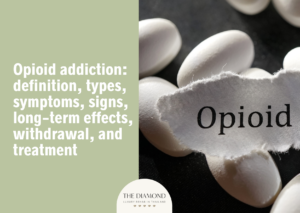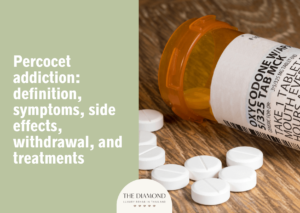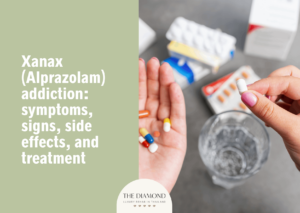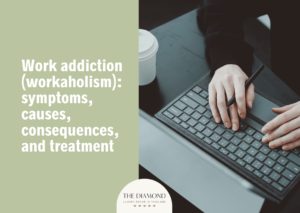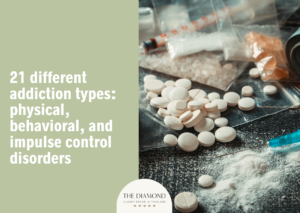Percocet addiction: definition, symptoms, side effects, withdrawal, and treatments
Table of content

Percocet addiction describes a mental and physical reliance on the prescription medication combining acetaminophen and oxycodone. Cravings and tolerance drive compulsive drug use, resulting in withdrawal symptoms if use is stopped.
The symptoms of Percocet addiction include insomnia, shallow breathing, mood swings, constipation, fatigue, increased tolerance withdrawal symptoms, stealing or borrowing Percocet, seeking money to purchase Percocet, using Percocet in unsafe situations and social isolation.
The side effects of Percocet addiction are nausea and vomiting, dizziness, confusion, headaches, itchiness or rash, loss of appetite, stomach pain and sedation.
The most common Percocet withdrawal symptoms are sweating, shaking (tremors), anxiety, irritability, muscle aches, chills, diarrhea and watery nose and eyes.
Treatment options for Percocet addiction include detoxification, medication-assisted treatment (MAT), cognitive behavioral therapy (CBT), support groups, counseling and aftercare programs.
What is Percocet addiction?
Percocet addiction describes a state of physical or psychological dependence on the prescription medication containing oxycodone and acetaminophen. Consistent usage modifies brain chemistry, resulting in an intense compulsion to persist in drug consumption regardless of health, social or financial repercussions.
As dependence intensifies, Percocet addiction is considered a form of opioid addiction, as it shares similar patterns of compulsive use and drug-seeking behavior. Strong cravings are a feature of the disorder, as is a decreased capacity to control or cease use without expert assistance.
How common is Percocet addiction?
Percocet addiction is common, as data from the 2024 publication titled “Key Substance Use and Mental Health Indicators in the United States: Results from the 2023 National Survey on Drug Use and Health” from the Substance Abuse and Mental Health Services Administration show 31.3 percent of individuals who misused prescription pain relievers in the past year—about 2.6 million people—used oxycodone-based medications, a category that includes Percocet.
Misuse often begins with legitimate pain treatment but progresses as tolerance and dependence develop. Without timely intervention, continued misuse escalates into a severe substance use disorder requiring professional treatment.
What is Percocet?

Percocet is a prescription pain medication meant to help with moderate to severe pain. It has oxycodone/paracetamol, meaning oxycodone is the main pain-relieving ingredient and paracetamol makes it work better.
As a potent semisynthetic opioid agonist, oxycodone works by binding to certain brain and spinal cord receptors to lessen pain perception and induce relaxation. Acetaminophen, likewise known as paracetamol, helps lower fever and relieve pain.
Why is Percocet addictive?
Percocet is addictive because the medication contains oxycodone, a potent opioid influencing the brain’s reward and pleasure systems. Opioid receptor binding prevents pain signals from reaching the brain while inducing a euphoric sensation, encouraging continued consumption.
As the brain adapts, natural dopamine production declines, reducing the ability to experience pleasure without the drug. The ensuing chemical change impairs self-control and feeds recurring cravings. Percocet use strengthens the urge to continue using in spite of negative effects because it changes the way the brain interprets pain and pleasure.
Psychological dependence intensifies as users depend on the drug to manage stress or discomfort. Emotional dependence and bodily adaptation combine to create a potent loop keeping addiction going.
How long does it take to get addicted to Percocet?
Addiction to Percocet is likely to develop within several weeks of consistent use, depending on dosage, frequency and individual vulnerability. Consistent exposure to opioids induces neuroadaptation, leading to physiological dependency and withdrawal in approximately four to eight weeks among opioid-naïve individuals, according to a 2016 study by Sharma et al., titled “Opioid Use Disorders.”
Individuals with a history of dependence frequently encounter a more rapid onset upon the resumption of opiate use. It is, however, important to note that addiction differs from dependence, as dependence involves physical adaptation to the drug, while addiction includes compulsive use and cravings despite harm.
In a 2012 editorial by John Doe, called “My Story: How one Percocet Prescription Triggered my Addiction,” the author was prescribed Percocet (oxycodone/acetaminophen) with caffeine for pain management and anticipated quick relief.
Although the medication failed to completely relieve the headache, a euphoric sensation emerged, boosting energy, focus and stress regulation, encouraging further use after recovery. A legitimate prescription fostered a false sense of safety, postponing recognition of growing dependence.
When the supply ran out, withdrawal symptoms such as fatigue and low mood developed. Employment as a nurse in an emergency department allowed access to controlled substances, resulting in drug diversion through falsified disposals within the Pyxis system.
What are the Percocet addiction symptoms?
Percocet addiction symptoms refer to the indications a person is reliant on or addicted to the drug. The most common Percocet addiction symptoms are listed below.
- Insomnia: Percocet disrupts normal sleep patterns, leading to restless nights and difficulty maintaining a regular sleep schedule. A 2023 study by Duo et al., called “Sleep disorders in chronic pain and its neurochemical mechanisms: a narrative review” revealed opioid usage is associated with a 30% increased risk of poor sleep quality and around a 15% elevated risk of reduced sleep duration in older persons suffering from chronic pain (CP). Additionally, the risk of sleep apnea and disordered breathing is increased by chronic opioid use, contributing to increased mortality in non-cancer CP patients.
- Shallow breathing: Shallow breathing is a serious symptom of Percocet use, particularly when the drug is taken in high doses. Opioids like oxycodone slow down breathing to dangerously low levels, reducing oxygen flow to the brain and other vital organs. The resulting oxygen deprivation causes dizziness, confusion or even loss of consciousness in severe cases.
- Mood swings: Emotional instability emerges as brain chemistry shifts in response to regular Percocet use. Individuals alternate between irritability, euphoria and sadness without clear triggers. Unpredictable emotions strain communication and create tension within relationships. Prolonged imbalance contributes to heightened anxiety and reduced emotional resilience.
- Constipation: Oxycodone, the opioid component of Percocet, causes constipation by disrupting normal digestive processes. A 2024 paper by Squeo et al., titled “Opioid-induced Constipation: Old and New Concepts in Diagnosis and Treatment” explained opioids alter the movement and fluid absorption within the digestive system. The drugs slow muscle activity responsible for moving food through the intestines, leading to tightened and cramping walls. Fluid secretion in the intestines decreases, resulting in dry, hardened stool.
- Fatigue: Constant drowsiness or exhaustion commonly develops as the body adjusts to the sedative effects of opioids. Energy levels drop, making concentration and motivation difficult to sustain. Daily responsibilities begin to feel overwhelming, further encouraging inactivity. Persistent fatigue weakens both mental alertness and physical health over time.
- Increased tolerance: Over time, the body adapts to the effects of Percocet, requiring larger doses to achieve the same level of relief or satisfaction. The original prescription becomes less effective, prompting more frequent or higher consumption. The gradual adjustment signals deepening dependence and growing resistance to the drug’s intended effects. As tolerance builds, the risk of overdose and severe side effects rises significantly.
- Withdrawal symptoms: When drug use suddenly stops, the body reacts strongly to the absence of opioids. Physical discomfort and emotional distress surface as the system struggles to regain balance. The experience feels overwhelming, driving an intense desire to resume use. Without medical guidance, the process becomes difficult to manage and leads to relapse.
- Stealing or borrowing Percocet: A person with growing dependence is likely to attempt to obtain Percocet without a prescription, often through deceit or manipulation. The behavior signals an inability to control use and prioritizes the drug over honesty or trust. Individuals justify the actions as necessary to avoid discomfort or withdrawal.
- Seeking money to purchase Percocet: Persons struggling with addiction often find themselves asking for loans or stealing cash to fund drug use. Financial instability grows as more income is directed toward obtaining the medication. The behavior reflects a shift in priorities, where satisfying cravings outweighs personal or professional obligations. Continuous financial deception frequently leads to guilt, stress and damaged credibility.
- Using Percocet in unsafe situations: Abuse continues even during hazardous circumstances, such as mixing with alcohol or driving under the influence. Engaging in such actions demonstrates impaired judgment and diminished regard for personal safety. The sedative effect of opioids intensifies risk, leading to accidents or overdose.
- Social isolation: Addicted individuals withdraw from friends, family and social activities to conceal drug use or avoid confrontation. According to a 2021 study by Nina C. Christie, titled “The role of social isolation in opioid addiction,” opioid users frequently experience high stigma, including public shame, family rejection and doctor reluctance, in addition to unstable networks, employment and education. Stigma criminalizes opioids, resulting in isolation following detention. In severe cases, unemployment reaches 87%, limiting the number of “work friends.” Opioids pose a 14-fold increased risk of suicide (compared to 6 for alcohol and 20 for multiple substances).
What are the side effects of Percocet addiction?

Side effects of Percocet addiction refer to the changes resulting from prolonged or excessive use of the drug. The side effects of Percocet addiction are listed below.
- Nausea and vomiting: Nausea and vomiting are common side effects of Percocet addiction due to the way opioids interact with the digestive system and the brain’s vomiting center. Opioid-induced nausea and vomiting (OINV) is a highly distressing symptom often mistaken for a sensitivity reaction instead of a normal pharmacological effect expected to subside within days after starting opioid treatment, according to a study by Barnes et al., titled “Opioid analgesics: Managing the predictable” published in May 2025.
- Dizziness: Dizziness is a frequent side effect of Percocet use, caused by the drug’s effect on the central nervous system and blood pressure. Individuals experience a feeling of lightheadedness or unsteadiness, especially when standing up quickly. Particularly risky for the elderly and those with preexisting health issues, dizziness heightens the likelihood of accidents and falls.
- Confusion: Confusion is a cognitive side effect of Percocet addiction, where the person struggles to think clearly, remember things or make decisions. The medication alters normal brain activity by slowing communication between nerve cells and reducing alertness. Disorientation, poor judgment and difficulty completing daily duties are the consequences of mental fog.
- Headaches: Headaches are a potential side effect of Percocet use, either as a direct result of the drug’s impact on the brain or as a rebound effect when the medication wears off. Dehydration, tension and withdrawal from missed doses further intensify head pain. Persistent headaches indicate dependence or improper dosage requiring medical evaluation.
- Itchiness or rash: Percocet triggers itchiness or rash when oxycodone prompts the body to release histamines from skin cells. The chemical reaction irritates nerve endings, creating sensations of itching or mild redness. A 2024 review by Okutani et al., called “Mechanisms and treatment of opioid-induced pruritus: Peripheral and central pathways” indicated opioids treat severe pain after surgery or during cancer care but often cause itching in up to 90% of cases, especially with spinal or epidural use. Pain and itch share nerve pathways, and opioids disrupt the balance, blocking pain control and triggering itch instead.
- Loss of appetite: Percocet affects areas of the brain regulating hunger, reducing the natural desire to eat. The drug slows digestion, creating a sensation of fullness even after small amounts of food. Nausea and stomach discomfort linked to opioid use tend to discourage eating even more.
- Stomach pain: Abdominal pain develops as the digestive system struggles to function properly under the influence of opioids. The body’s slowed internal movement causes food and gas to remain longer in the intestines, increasing discomfort. Percocet interferes with normal muscle coordination, resulting in cramping or a tight sensation.
- Sedation: Sedation occurs because the oxycodone in Percocet depresses central nervous system activity. Brain signals slow down, reducing alertness and reaction time. Users describe a heavy, drowsy feeling, hindering concentration. With continued use, mental sharpness fades, increasing the risk of accidents or unintentional sleep.
What are the Percocet withdrawal symptoms?
Percocet withdrawal symptoms refer to the range of effects emerging when a person dependent on Percocet suddenly reduces or stops using the drug. The most common Percocet withdrawal symptoms are listed below.
- Sweating: Excessive sweating is a common sign of drug withdrawal as the body struggles to stabilize temperature without Percocet. A sudden drop in opioid levels activates the autonomic nervous system, leading to heavy perspiration, particularly during sleep. The body reacts to internal stress while trying to regain chemical balance. Persistent night sweats indicate the system’s ongoing effort to adjust after dependence.
- Shaking (tremors): Shaking or tremors are involuntary muscle movements linked to the nervous system’s heightened sensitivity during withdrawal. The body reacts to the loss of Percocet with unsteady movements, affecting the hands and limbs. The response reflects the system’s struggle to regain normal function. Tremors usually ease once the body rebalances after detoxification.
- Anxiety: Anxiety is a common psychological symptom of Percocet withdrawal, characterized by feelings of worry, nervousness and fear. Opioid withdrawal symptoms (OWS) such as anxiety generally subside within 5 to 14 days, contingent upon the opioid’s half-life; nonetheless, the distress experienced in the initial days following cessation is intense, according to a 2019 paper by Thomas R. Kosten and Louis E. Baxter, titled “Review Article: Effective Management of Opioid Withdrawal Symptoms: A Gateway to Opioid Dependence Treatment.”
- Irritability: Irritability appears as the brain struggles to function without the calming influence of oxycodone. Emotional stability weakens, causing quick frustration or anger over minor issues. Irritability is recognized as a component of negative affect in people during acute withdrawal and as chronic irritability in prolonged stages, according to a 2023 study by Ozdemir et al., titled “Advances in the characterization of negative affect caused by acute and protracted opioid withdrawal using animal models.”
- Muscle aches: Muscle aches and pains develop during withdrawal when the body reacts to the sudden absence of Percocet. The medication dulls pain signals, so discomfort returns once use stops. Soreness and stiffness spread through the body as nerves regain sensitivity.
- Chills: Chills, often paired with goosebumps and shivering, occur as the body struggles to stabilize during Percocet withdrawal. Disrupted temperature control triggers sudden waves of cold. As recovery progresses, the symptom gradually fades and body temperature steadies.
- Diarrhea: The intestines, previously slowed by Percocet, begin to contract too quickly, pushing waste through the system faster than normal. The rapid activity prevents proper absorption of fluids, resulting in loose stools. A 2020 review article by Pergolizzi et al., titled “Opioid withdrawal symptoms, a consequence of chronic opioid use and opioid use disorder: Current understanding and approaches to management” revealed how after opioid discontinuation, the body releases excessive norepinephrine, a chemical responsible for various acute physical symptoms of withdrawal, including diarrhea.
- Watery nose and eyes: Runny nose and watery eyes resemble the onset of a common cold. The body’s sudden adjustment triggers excessive fluid secretion from glands controlled by the nervous system. Mucus levels rise as the body works to regain equilibrium. Such reactions signal the system’s attempt to restore normal function.
What are the treatments for Percocet addiction?

Treatments for Percocet addiction are different types of programs meant to help people stop being dependent on Percocet. The treatments for Percocet addiction are listed below.
- Detoxification (detox): Detoxification marks the first stage of treatment for Percocet addiction, involving the gradual reduction of drug use under medical guidance. Medical professionals oversee the process to ease withdrawal discomfort and maintain safety. The duration usually spans several days to a week, depending on the level of dependence. Once complete, the body begins to operate without the influence of the substance.
- Medication-assisted treatment (MAT): Medication-assisted treatment uses drugs such as methadone, buprenorphine or naltrexone to ease withdrawal discomfort and curb cravings. The prescribed medications either safely replicate opioid effects or block them entirely to support recovery. Retention of buprenorphine and methadone therapy has been associated with significantly lower rates of overdose-related and all-cause mortality in individuals with opioid use disorder (OUD), according to the second chapter of the book “Medications for Opioid Use Disorder Save Lives” published in 2019 by the National Academies Press (US).
- Cognitive behavioral therapy (CBT): Cognitive behavioral therapy helps individuals recognize and change negative thought patterns driving substance use. The method encourages healthier behavioral reactions to stressors and triggers while fortifying coping mechanisms. An increased retention rate among patients engaged in MAT for opioid use was observed in a 2024 report by LeBlanc et al., called “Outcomes of adding cognitive behavioral therapy to medication-assisted treatment for opioid use disorder” when a policy was implemented involving a consistent 60 minutes of individual CBT every other week, in addition to the prescribed medication and group counseling twice a week.
- Support groups: Support groups like Narcotics Anonymous (NA) create a sense of belonging through shared experiences and mutual encouragement. Members follow a structured 12-step program fostering accountability and personal growth. The collective support strengthens motivation to stay sober and maintain lasting recovery.
- Counseling: Counseling involves one-on-one or group sessions with a trained counselor or therapist to explore the underlying issues contributing to Percocet addiction. A 2023 meta-analysis by Wen et al., titled “Comparative efficacy of psychosocial interventions for opioid-dependent people receiving methadone maintenance treatment: A network meta-analysis” confirmed educational and behavioral counseling, alongside CBT, proved among the most effective psychosocial approaches for individuals undergoing methadone maintenance therapy for opioid dependence.
- Aftercare programs: Aftercare programs offer continued guidance and resources following primary Percocet treatment. Through therapy, support groups and regular consultations with professionals, participants strengthen coping skills and sustain recovery. Ongoing engagement reinforces accountability and lowers relapse risk.
How to overcome Percocet addiction?
To overcome Percocet addiction, one must first make a deliberate decision to stop taking the medication and get help from a medical professional. The safe management of withdrawal symptoms and avoidance of extreme discomfort during Percocet detox depend on medical guidance.
Physicians often recommend a tapering plan, where dosage is gradually reduced to lessen withdrawal intensity. Support from healthcare providers helps monitor progress and adjust treatment as needed.
Establishing new coping mechanisms via counseling or cognitive behavioral therapy enhances emotional resilience and strengthens drive. During recovery, relapse prevention takes center stage and involves consistent therapy, support groups and lifestyle modifications.
Engaging in peer support groups or community-based initiatives promotes responsibility and mutual healing. After detox and therapy, ongoing aftercare ensures continued stability. Setting specific objectives and sticking to a recovery schedule support long-term sobriety and personal development.
When is Percocet addiction counseling necessary?
Percocet addiction counseling becomes necessary once a person struggles to manage drug use, feels intense cravings or keeps using despite harmful effects on relationships, career or health.
Mental fixation on obtaining or using Percocet further signals the need for structured therapy. Failed self-directed attempts to stop usually highlight the depth of the problem and the need for professional help.
Counseling encourages emotional healing and strengthens self-awareness, allowing individuals to understand the roots of substance misuse. Consistent sessions augment drive for transformation and reinstate a sense of agency in daily life.
What are the Percocet addiction causes?
Percocet addiction causes are the several variables contributing to the emergence of a Percocet addiction. The most common Percocet addiction causes are listed below.
- Genetic predisposition: A family history of substance misuse increases the risk of Percocet addiction. Inherited traits affect how the brain processes reward and pleasure, making opioid effects more reinforcing. According to a 2021 paper by Brian Reed and Mary Jeanne Kreek, titled “Genetic Vulnerability to Opioid Addiction,” research on families and twins indicates opioid addiction has a significant genetic component, with heritability accounting for approximately 50% of the risk, similar to alcoholism and cocaine addiction. Genetics influence not just the initiation of opioid usage but the progression to addiction as well.
- Mental health disorders: Certain psychological conditions drive reliance on Percocet for emotional relief. The temporary calm produced by the drug encourages repeated use and dependence. OUD is more likely to occur in patients with a history of untreated anxiety, depression, post-traumatic stress disorder (PTSD) or childhood trauma, as noted in a continuing education activity by Dydyk et al., titled “Opioid Use Disorder: Evaluation and Management” last updated in January 2024.
- Environmental influences: Exposure to environments where prescription drug use is common increases the risk of misuse. Peer pressure or family dynamics normalizing opioid use encourage unhealthy habits. Limited social support and poor access to treatment further worsen the issue. External stressors within one’s surroundings sustain the cycle of dependency.
- Tolerance development: Prolonged Percocet use prompts the body to adapt, diminishing the drug’s effect. Higher doses become necessary to achieve the same level of pain relief or euphoria. As intake rises, physical dependence strengthens. The escalation of consumption leads to compulsive use and difficulty stopping without help.
- Stress: Persistent stress—whether emotional, physical or psychological—creates a strong trigger for misuse. Numerous individuals turn to Percocet to escape discomfort or pressure. The brief relief reinforces continued use, forming a self-perpetuating pattern. Unmanaged stress therefore becomes a powerful driver of addiction.
What are the risk factors for Percocet addiction?

Risk factors for Percocet addiction are conditions or influences raising a person’s chance of becoming addicted to the drug. The risk factors for Percocet addiction are listed below.
- Ease of access: Easy access to Percocet through prescriptions or illegal sources heightens the likelihood of addiction. People prescribed the medication for pain secure frequent refills or visit several doctors to obtain more doses, a practice known as doctor shopping. Limited monitoring of prescriptions worsens the issue, allowing misuse to progress unnoticed. Stronger control measures and patient education help reduce the risk.
- Previous substance abuse: A history of substance abuse increases vulnerability to developing dependence on Percocet. Prior exposure to addictive substances alters brain chemistry, causing stronger reactions to the euphoric effects of opioids. A 2020 study by Campbell et al., titled “Risk factors for indicators of opioid-related harms amongst people living with chronic non-cancer pain: Findings from a 5-year prospective cohort study” found a consistent link between problematic opioid use and prior substance dependence. The research followed 1,514 participants prescribed opioids over five years, revealing a clear pattern between past addiction and future misuse.
- Peer pressure: Peer pressure is a significant risk factor for Percocet addiction, especially among teenagers and young adults. Being in a social circle where drug use is common or encouraged leads individuals to try Percocet, often out of a desire to fit in or avoid rejection. The influence of friends tends to cloud judgment and downplay potential harm.
- Impulsivity: Individuals with impulsive tendencies act without considering long-term consequences, increasing the likelihood of drug misuse. A spontaneous decision to use Percocet for quick relief or pleasure is likely to progress into habitual use. As per a 2018 study by Kozak et al., called “The neurobiology of impulsivity and substance use disorders: implications for treatment,” impulsivity arises when emotional and reward-driven impulses overpower rational control. Substance use disorders (SUDs) intensify the imbalance, leading to risky decision-making and a higher likelihood of relapse.


